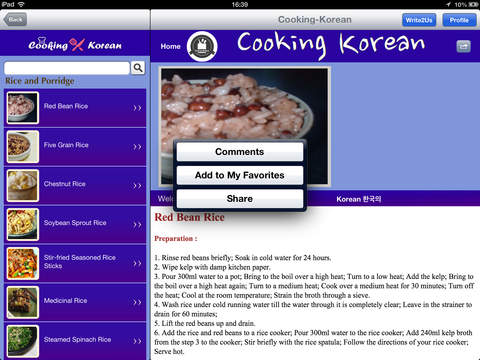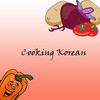cooking-korean
Detailed App Info:
Application Description
Welcome to our dual language Korean food and recipe app. Typical meals in South Korea are generally not served in courses, but all at once. Usually, there are also many side dishes (banchan) that accompany the main course, which are laid out together on the table. Steamed rice served with the soup is also the foundation of most Korean meals, while Kim chi, a spicy fermented cabbage is the vegetable staple, which is served with nearly all Korean meals in the South of the country. Kim chi, will often be consumed at lunch, dinner and even breakfast.
Given the belief that medicine and food originate from the same sources, Korean cuisine, emphasizes a balanced diet. In addition to balancing the portions of meat and vegetables, there exists a "five colors" concept, which is also taken into account when preparing a meal. "Five colors" refers to red, yellow, white, black and green, which are the colors one should expect when eating a formal Korean meal. South Koreans believe that food with different colors contains different nutrients, and thus the health benefits are increased.
Food with red color is believed to help carry oxygen from the lungs to the muscles and other organs. Red chili pepper can be found in the South Korean meal very often as a "red" food. Food with yellow color is believed to help detoxify the bloodstream and thus Corn and banana are often used. Foods with white color are believed to help maintain the health of the heart. Examples of white foods are the Daikon radish and pears. Food with black color is believed to help speed up the metabolism. Black sesame seeds and mushrooms are used in many instances as black food elements. Foods with green color are believed to help strengthen kidney and liver. Spinach and cucumber can often be found in a typical South Korean meal.
In spite of being based on the same theories of color variations, dishes from different regions in South Korea vary in tastes. In a nut shell, the dishes from the southern part of the country are more pungent, while the dishes from the northern part are more delicate and the taste is more subtle. There was a time when Korean food from the North took on its own special characteristics, but unfortunately, the North is too impoverished and food much too scarce now. Most of the traditional North Korean foods are no longer found in the North, except for a few specialty restaurants in Seoul.
The recipes you will fine here are a true representation of the lifestyle and richness of Korean food culture. We will update them regularly too. Use the app when shopping at your local Korean or Asian grocery store to help you pick the correct ingredients. I hope you enjoy them all, "gal meokkesseumnida!" (잘 먹겠습니다)
Given the belief that medicine and food originate from the same sources, Korean cuisine, emphasizes a balanced diet. In addition to balancing the portions of meat and vegetables, there exists a "five colors" concept, which is also taken into account when preparing a meal. "Five colors" refers to red, yellow, white, black and green, which are the colors one should expect when eating a formal Korean meal. South Koreans believe that food with different colors contains different nutrients, and thus the health benefits are increased.
Food with red color is believed to help carry oxygen from the lungs to the muscles and other organs. Red chili pepper can be found in the South Korean meal very often as a "red" food. Food with yellow color is believed to help detoxify the bloodstream and thus Corn and banana are often used. Foods with white color are believed to help maintain the health of the heart. Examples of white foods are the Daikon radish and pears. Food with black color is believed to help speed up the metabolism. Black sesame seeds and mushrooms are used in many instances as black food elements. Foods with green color are believed to help strengthen kidney and liver. Spinach and cucumber can often be found in a typical South Korean meal.
In spite of being based on the same theories of color variations, dishes from different regions in South Korea vary in tastes. In a nut shell, the dishes from the southern part of the country are more pungent, while the dishes from the northern part are more delicate and the taste is more subtle. There was a time when Korean food from the North took on its own special characteristics, but unfortunately, the North is too impoverished and food much too scarce now. Most of the traditional North Korean foods are no longer found in the North, except for a few specialty restaurants in Seoul.
The recipes you will fine here are a true representation of the lifestyle and richness of Korean food culture. We will update them regularly too. Use the app when shopping at your local Korean or Asian grocery store to help you pick the correct ingredients. I hope you enjoy them all, "gal meokkesseumnida!" (잘 먹겠습니다)
Requirements
Your mobile device must have at least 8.05 MB of space to download and install cooking-korean app. cooking-korean is available on iTunes for $0.99
If you have any problems with installation or in-app purchase, found bugs, questions, comments about this application, you can visit the official website of NOVEXCN Dean Polizzotto at http://www.cooking-korean.com/.
Copyright © 2013 Novexcn





